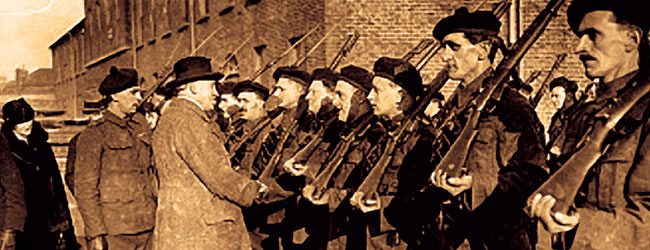12 May 2011
Remembering the Past
The ‘Partition Election’ and the Second Dáil Éireann
BY MAY 1921, the war in Ireland was at its most intense. The country was under British military rule with crown forces carrying out widespread murder, maiming, burning and looting. The resistance of the IRA had been stepped up with flying columns operating successfully in several parts of the country. British forces were under siege in their barracks and posts across large swathes of territory.
The West Cork IRA Flying Column, under Tom Barry, in March had successfully evaded an attempt at encirclement by a large enemy force, including aircraft, at Crossbarry, an engagement that went down in the history of guerrilla warfare. In Britain, there was growing pressure on the Tory/Liberal Government led by Prime Minister Lloyd George to bring about a negotiated settlement, with Britain’s image growing ever grimmer in the eyes of the world as the atrocities of the Black and Tans and Auxiliaries were exposed.
Lloyd George was determined to force the implementation of the Government of Ireland Act which had been passed the previous December and which provided for the partition of Ireland and the establishment of a ‘Northern Parliament’ for the Six Counties and a ‘Southern Parliament’ for the 26 Counties. Above all, he wanted to retain the whole of Ireland in the British Empire. He told his cabinet: “I am afraid that in our anxiety to put an end to a disagreeable business which brings no credit to the Government or to the country, we may pay a price which this country will regret later.”
Lloyd George decided to proceed with elections to the two partition parliaments, even though he knew Sinn Fein would sweep the boards in the 26 Counties and refuse to sit in the ‘Southern Parliament’. In that case the British would continue with military rule, governing the 26 Counties as a crown colony. But what of the Six Counties? The Manchester Guardian predicted:
“The Ulster Parliament will function after a fashion, but it will be little more than a rump of a parliament, and it will carry no moral authority over a very large minority of the Ulster people. It will govern, but it will also be compelled to govern by force . . . The Ulster Volunteers, a kind of local Black and Tans, will become the arm of government in Northern Ireland.”
It was a very accurate prediction.
Sinn Féin decided to regard the election as an election to the Second Dáil; those elected would form the second national assembly, succeeding the First Dail Éireann established on 21st January 1919. They would refuse to have anything to do with Lloyd George’s ‘Southern Parliament’. The remnants of the Nationalist Party stood aside in the 26 Counties and there was no contest for seats with Sinn Féin candidates taking them all, except for four Independent unionist members.
In the Six Counties, Sinn Féin won six seats, the Nationalist Party six and the Unionist Party 40. Only the six Sinn Féin members took their seats in the Second Dáil, although all those elected in May 1921 were entitled and invited to do so.
In the North, nationalists and republicans had already experienced pogroms, notably in July 1920 in Belfast. They now had to fight the elections in the most unfavourable circumstances, subject as they were to widespread loyalist intimidation and violence. Nationalists and republicans won far fewer seats in Belfast than their numbers would have entitled them to, whereas in constituencies west of the Bann there were strong anti-partition votes. But the result was the same. Backed politically and militarily by the British Government, the new Unionist regime, led by Prime Minister James Craig, began building the repressive Orange state which was to last for half a century.
In Dublin on 25th May, the IRA’s burning of the Custom House, a centre of British administration, demonstrated that most of Ireland was ungovernable by Britain. Lloyd George admitted as much when he said that in the election “two thirds of the population of Ireland demand the setting up of an independent Republic in that island”. But he and his Cabinet continued to doggedly deny the will of the people, leading to the tragedy of the Treaty and the Civil War.
Elections for the Second Dail Eireann were held in May 1921, 90 years ago this month.
Republican women TDs
A NOTABLE FEATURE of the Second Dáil was the increase in women members, albeit still a small number. Only Constance Markievicz was elected in 1919 but in 1921 she was joined by Kathleen Clarke, Margaret Pearse, Mary Mac Swiney, Kathleen O’Callaghan and Ada English.
All the women of the Second Dáil opposed the Treaty. All were republicans in their own right. They resented the portrayal of their opposition to the Treaty as based only on the fact that some of them had male relatives who had died. This was expressed by Ada English who said during the Treaty debate:
“It was a most unworthy thing for any man to say here. I can say this more freely because, I thank my God, I have no dead men to throw in my teeth as a reason for holding the opinions I hold. I should like to say that I think it most unfair to the women Teachtaí.”
Follow us on Facebook
An Phoblacht on Twitter
Uncomfortable Conversations

An initiative for dialogue
for reconciliation
— — — — — — —
Contributions from key figures in the churches, academia and wider civic society as well as senior republican figures





